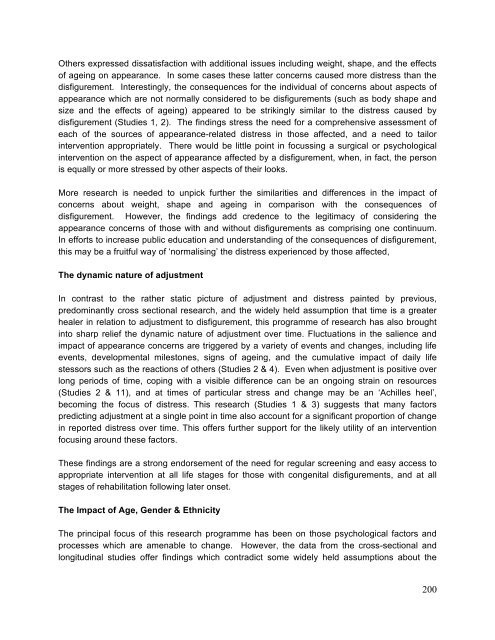Download the report - The Healing Foundation
Download the report - The Healing Foundation
Download the report - The Healing Foundation
Create successful ePaper yourself
Turn your PDF publications into a flip-book with our unique Google optimized e-Paper software.
O<strong>the</strong>rs expressed dissatisfaction with additional issues including weight, shape, and <strong>the</strong> effects<br />
of ageing on appearance. In some cases <strong>the</strong>se latter concerns caused more distress than <strong>the</strong><br />
disfigurement. Interestingly, <strong>the</strong> consequences for <strong>the</strong> individual of concerns about aspects of<br />
appearance which are not normally considered to be disfigurements (such as body shape and<br />
size and <strong>the</strong> effects of ageing) appeared to be strikingly similar to <strong>the</strong> distress caused by<br />
disfigurement (Studies 1, 2). <strong>The</strong> findings stress <strong>the</strong> need for a comprehensive assessment of<br />
each of <strong>the</strong> sources of appearance-related distress in those affected, and a need to tailor<br />
intervention appropriately. <strong>The</strong>re would be little point in focussing a surgical or psychological<br />
intervention on <strong>the</strong> aspect of appearance affected by a disfigurement, when, in fact, <strong>the</strong> person<br />
is equally or more stressed by o<strong>the</strong>r aspects of <strong>the</strong>ir looks.<br />
More research is needed to unpick fur<strong>the</strong>r <strong>the</strong> similarities and differences in <strong>the</strong> impact of<br />
concerns about weight, shape and ageing in comparison with <strong>the</strong> consequences of<br />
disfigurement. However, <strong>the</strong> findings add credence to <strong>the</strong> legitimacy of considering <strong>the</strong><br />
appearance concerns of those with and without disfigurements as comprising one continuum.<br />
In efforts to increase public education and understanding of <strong>the</strong> consequences of disfigurement,<br />
this may be a fruitful way of ‘normalising’ <strong>the</strong> distress experienced by those affected,<br />
<strong>The</strong> dynamic nature of adjustment<br />
In contrast to <strong>the</strong> ra<strong>the</strong>r static picture of adjustment and distress painted by previous,<br />
predominantly cross sectional research, and <strong>the</strong> widely held assumption that time is a greater<br />
healer in relation to adjustment to disfigurement, this programme of research has also brought<br />
into sharp relief <strong>the</strong> dynamic nature of adjustment over time. Fluctuations in <strong>the</strong> salience and<br />
impact of appearance concerns are triggered by a variety of events and changes, including life<br />
events, developmental milestones, signs of ageing, and <strong>the</strong> cumulative impact of daily life<br />
stessors such as <strong>the</strong> reactions of o<strong>the</strong>rs (Studies 2 & 4). Even when adjustment is positive over<br />
long periods of time, coping with a visible difference can be an ongoing strain on resources<br />
(Studies 2 & 11), and at times of particular stress and change may be an ‘Achilles heel’,<br />
becoming <strong>the</strong> focus of distress. This research (Studies 1 & 3) suggests that many factors<br />
predicting adjustment at a single point in time also account for a significant proportion of change<br />
in <strong>report</strong>ed distress over time. This offers fur<strong>the</strong>r support for <strong>the</strong> likely utility of an intervention<br />
focusing around <strong>the</strong>se factors.<br />
<strong>The</strong>se findings are a strong endorsement of <strong>the</strong> need for regular screening and easy access to<br />
appropriate intervention at all life stages for those with congenital disfigurements, and at all<br />
stages of rehabilitation following later onset.<br />
<strong>The</strong> Impact of Age, Gender & Ethnicity<br />
<strong>The</strong> principal focus of this research programme has been on those psychological factors and<br />
processes which are amenable to change. However, <strong>the</strong> data from <strong>the</strong> cross-sectional and<br />
longitudinal studies offer findings which contradict some widely held assumptions about <strong>the</strong><br />
200


